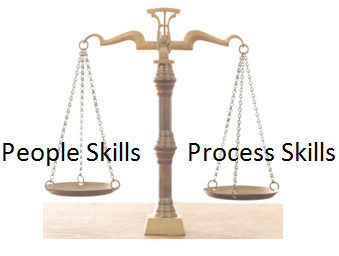October 2011
This month’s newsletter discusses the need to balance people and process in your process improvement efforts. As usual, your comments are welcomed. In this issue:
- Introduction
- What is Wrong with Focusing on Process Skills?
- What Process Skills are Needed?
- Bringing in the People Side of Process Improvement
- Summary
- Quick Links
Introduction
You are responsible for process improvement in your area. Maybe you are a Six Sigma Black Belt. You have been trained in how to “do” this. You know the steps to follow. So simple. But it is not working! Why not? You have spent weeks being trained. You have your thick training manual, your software, and your marching instructions from leadership. Your company has spent lots of money on getting you trained. But it is not working! And your boss wants to know why there are not more results coming from you.

One of my former bosses once told me that if I ever had my own company, don’t have any employees. Yes, adding people to the process automatically makes it difficult. If you have ever been on a team, you have probably experienced that. Yet, few, if any, of our process improvement methodologies address the people side of process improvement.
It doesn’t matter if those efforts are based on Six Sigma, Lean (or, of course Lean Six Sigma!), the Theory of Constraints, or statistical process control. Whatever your approach is, you are leaving something on the table if you don’t take into account the people side. And it is amazing how seldom process improvement methodologies do that. You may be audacious enough to think your method is a cure-all for everything that ails your organization so you call it a “business philosophy.” Still doesn’t matter. You probably are not accounting for the people skills needed.
For example, look through any Six Sigma training outline you can find. The vast majority of time you will find a methodology filled with statistical techniques for improving and controlling processes. But seldom do you find a balance between the people skills and the process skills that are needed for true process improvement to occur. Blending these two leads to a synergistic effect that approaches just based on process skills alone or people skills alone cannot touch.
This means that training should be balanced between the people and the process skills. And I mean balanced. Fifty-fifty. Because on the job, you will find that the people “stuff” takes the vast majority of your time. You need to be trained how to handle the people.
What does it take to be excellent? It takes great people working in great processes. You have to balance people and process. People skills means understanding the broad body of knowledge called “Motivation.” Process skills means understanding the broad boy of knowledge called “Variation.”
What is Wrong with Focusing on the Process Skills?

To complete my training, a few of us attended three weeks of statistical training at the University of Tennessee. Based on this training, I helped develop an internal four day SPC course that we gave to each of the 800 people employed in the company over a one year period. Management at the company was definitely committed to this. Training everyone is a commitment!
What do you think happened after all this training? Well, at best, 20% of the people were doing something with the training (the old Pareto principle again). So, we went even further. We asked QualPro back to train a group of us in experimental design techniques. Great techniques! Another group of us went back to the University of Tennessee for their three week experimental design course. Then, I helped develop another internal four day experimental design course that we gave to all the technical people (engineers, researchers, etc.) in the company.
What do you think happened after this training? About 20% of the people who were trained actually doing something with the training. Sound familiar (Pareto again)? Our process improvement efforts struggled over the years. But look at what we did. We focused on the process and statistical skills. There was nothing on the people side at all except for a brief mention of Dr. Deming’s fourteen points. We finally added some training on how to work in teams – our first step into the people skills needed for process improvement. But even that was insufficient, and the process improvement efforts finally died. Yes, we had some successes, but not nearly as many as we could have had. And that is what generates ongoing process improvement.
What Process Skills are Needed?
People in the organization do need to understand the process side. What you need to know depends on your role. If you are a Six Sigma Black Belt, you need in-depth training in those process skills. A Six Sigma Green Belt, you don’t need as much. That is something your organization must decide based on your improvement methodology. Process skills can include:
- Pareto Diagrams
- Process Flow Diagrams
- Histograms
- Control Charts
- Scatter Diagrams
- Process Capability
- Cause and Effect Diagrams
- Measurement Systems Analysis
- Regression
- Experimental Design Techniques
- Analysis of Variance
- Descriptive Statistics
- Comparing Averages and Variances
- Correlation Analysis
- Scatter Plot Matrix
- Waterfall Charts
- Sample Size Analysis
- Nonparametric Analysis
Most process improvement methodologies include some of these items. There are many more. And people do need to understand how to use these process techniques. Knowledge of some or most of these skills are necessary for process improvement, but, alone, they are not sufficient. You must bring in the people side.
Bringing in the People Side of Process Improvement 
After I left that job, I was fortunate enough to work with a consulting firm that on was on the cutting-edge. This consulting firm developed an initial process improvement methodology that was based on a balance between the people skills and process skills needed to bring about lasting improvement. And the people side is much more than learning how to work in teams. It was only then that I began to totally understand the importance of people and process. This synergistic approach to process improvement produces bottom-line results that greatly exceed those of other approaches. Yes, there are those companies who focus only on teams. And they are not any more successful than those that focus just on the process side.
So what are the types of people skills needed? Below is a list of some of the people skills that should be part of your process improvement methodology. Again, how much each individual is exposed to this knowledge depends on their role in the organization. And the list could be much longer.
- Importance of Internal Customers and Suppliers
- Teamwork
- Team Meeting Skills
- Motivation
- Feedback
- Recognition and Reinforcement
- Change
- Creativity
- Paradigms
- Social Styles
- Flexibility
- Influence
Many times when we think of process improvement, we think of how we can provide better service to the external customers. But often, improving service to the external customer begins by improving service to the internal customer. People need to understand that improving service to internal customers improves service to external customers and increases efficiency by driving out waste and rework. And as you focus on internal customer/supplier relationships, you will increase communication, positive attitudes, respect for others, and teamwork. All that stuff on the people side.
Teamwork is essential for projects to be successful. People need to be trained on the skills needed to help build and maintain teamwork. This includes how to build a healthy team by balancing task (getting the job done) and maintenance (ensuring everyone feels unique and appreciated). Consensus decision-making is critical to a team’s success, so people need to be trained in how to make true consensus decisions.
Team meetings are required to complete projects. People need to know how to have successful meetings. To be successful, team meetings must be planned properly. In addition, behavior during team meetings must be managed to ensure that team synergy is achieved. Training is needed on the role of the leader, members, minute taker and facilitator as well as the active listening skills required for a team leader to be successful. Team leaders need to know how to prepare for a team meeting, lead a team meeting and follow-up between meetings.
What motivates you? What motivates others? Are you goal oriented? Are you a problem solver? People need training in what extrinsic and intrinsic motivation is and how to impact them. They need to understand the various motivation theories such as those by Maslow and Herzberg. Vision is an important part of motivation.
The easy way to improve performance is to increase feedback. People should understand the impact of the various types of feedback (coaching, negative, positive, and silent) and how to use each one. Feedback provides the opportunity for recognition and reinforcement. Recognition is acknowledging person’s contribution to a project or a success. There are four types of reinforcement: positive, negative, punishment and extinction.
Change is always with us, but is often challenging. Creativity often brings forth change. There are skills that can be used to help people be creative. Train your people in those skills. People should understand the role of paradigms and how paradigms impacts their thinking.
Social styles let us understand ourselves and how we act as well as other people and how they act. Quadrant theory provides a simple way of looking at ourselves in one of four quadrants (driver, analytical, amiable, and expressive). Your company may be using something else already like Myers-Briggs.
Knowing social styles allows us to be flexible. We can flex to other people’s styles to make them more comfortable.
And last is influence. Often, as people trying to make something happen, we only have our influence to win over other people. Yet, far too often, our training neglects to teach us how to influence others.
Summary
The key message from this newsletter is balance. All your process improvement training should balance people and process. Your organization has to decide what process skills and people skills to include. But leaving out one or focusing too heavily on one takes away from the effectiveness of your process improvement efforts.
I would recommend that you spend a morning on one of the two and the afternoon on the other. About half the people will love the people skills; the other will love the process skills. Balancing these two will result in a synergistic effect. Take a look at your training. Is it balanced? If not, what do you have to do to make it balanced?


Toastmasters provides valuable opportunities to learn, practice, and improve people skills in a friendly, supportive environment. Every people skill that you mentioned (and more) is covered in the Toastmasters communication and leadership educational program.
Good articles.
Please keep them coming.
please continue sending me good articles
Absolulately in agreement with your views. Sophisticated machines can not do wonders but motivated people can !
Completely agreed
It is indeed a very useful article.
We need to pay atention to a people side of our teams.
Without commitment and ownership , any Improvement iniciative is condemned to a big fail.
Good article!!!
Yuri Espinosa
Sitel-PIPM (Lean Six Sigma Black Belt)